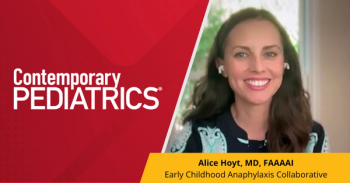
Asthma Therapy Complicated by Peters Plus Syndrome
The authors describe the case of a 2-year-old girl with severe persistent asthma whose disease management was complicated by this rare clinical diagnosis.
Corticosteroids are a mainstay of therapy for patients with a variety of conditions, such as asthma. Short-term oral corticosteroid management often is required for acute attacks. In persistent asthma, an inhaled corticosteroid is recommended to provide symptom control.
The adverse effects of corticosteroids must be considered, however, particularly in patients who have coexisting disease for whom these medications present an added risk.
Peters plus syndrome (PPS), a constellation of multiple diseases, features Peters anomaly. This anterior ocular segment defect predisposes patients to increased intraocular pressure and glaucoma, which can be complicated by corticosteroid therapy.
In this report, we describe the case of a 2-year-old girl with severe persistent asthma whose disease management was complicated by a clinical diagnosis of PPS.
Case
Our patient was born via normal spontaneous vaginal delivery at 34 weeks and was admitted to the neonatal intensive care unit (NICU) for prematurity. Her weight, length, and head circumference were appropriate for her gestational age. Findings included wide open fontanelles, brachycephaly, frontal bossing, narrow eyes, a smooth philtrum, a groove on her upper labia majora, bilateral fifth digit clinodactyly, a sacral tuft of hair, an absence of suck reflex, cleft lip and alveolus, and bilateral corneal opacities.
A clinical diagnosis of PPS was made on the basis of the presence of Peters anomaly and the typical dysmorphic facies. The findings of subsequent chromosomal analysis were unremarkable. The patient was discharged after a 1-month NICU stay.
Since then, the patient has experienced complications, including pneumonia, respiratory syncytial virus bronchiolitis, and bilateral hydronephrosis. At 4 months, a left iridectomy was performed for increased intraocular pressure. The patient has had several pediatric ICU admissions for asthma exacerbations, for which she has been treated with albuterol and corticosteroids (inhaled, intravenous, and oral). Bilateral cataracts developed at age 2 years.
Discussion
Fewer than 80 patients have been reported to have PPS, an autosomal recessive disorder composed of anterior eye chamber and extraocular abnormalities.1 The abnormalities include short stature, developmental delay, a prominent forehead, narrow eyes, a smooth philtrum, and a broad neck. Less common manifestations include spinal and kidney abnormalities. All of the abnormalities and less common manifestations are present in this patient.1
Peters anomaly is a hallmark of PPS that leaves patients susceptible to ocular hypertension and thus glaucoma, but certain iatrogenic factors, such as the use of corticosteroids, also may contribute to increased intraocular pressure. The mechanism is multifactorial. An increased accumulation of glycosylaminoglycans is thought to contribute to ocular hypertension.2
The association between oral corticosteroid therapy and increased intraocular pressure is well established, but there is less certainty about inhaled corticosteroids.3-5 They have not been shown to increase ocular pressure in a statistically significant number of patients.4 However, a few instances of ocular hypertension in patients receiving inhaled corticosteroids for asthma have been documented.5
In patients with underlying ocular disease, especially defects that predispose to increased intraocular pressure, the risks and benefits of inhaled and oral corticosteroid therapy should be considered carefully. The treatment of glaucoma in this patient with Peters anomaly has proved challenging. In one study of patients with PPS afflicted by glaucoma, only 32% exhibited response to corrective surgery.6 This statistic alone underscores the importance of ocular hypertension prevention.
Intraocular pressure management has been an issue for our patient, given her history of iridectomy. Therefore, to manage her asthma exacerbations, it may be beneficial to avoid oral and intravenous corticosteroids and to consider adding a nonsteroidal option, such as anti-IgE antibody therapy, to her existing inhaled corticosteroids.
Recent studies suggest that anti-IgE antibodies, such as omalizumab, are effective in treating asthma in children, particularly those in the inner city.7-9 In addition, omalizumab reliably reduces the long-term corticosteroid burden in this population.
We think that the relatively benign adverse-effect profile of omalizumab makes it particularly attractive for use in the pediatric population.9 However, this medication requires outpatient visits for subcutaneous injection every 2 to 4 weeks, which can be problematic in patients who demonstrate poor follow-up.
At present, our patient, nearly 3 years old, continues to be monitored for severe persistent asthma with frequent prolonged hospitalizations. Because we have struggled with the patient’s poor follow-up, management remains a challenge. However, if the patient’s family is amenable, we hope to discuss omalizumab therapy for her during future visits.
References
1. Aubertin G, Kriek M, Lesnik Oberstein SA. Peters Plus Syndrome. GeneReviews. 2011. http://www.ncbi.nlm.nih.gov/books/NBK1464/. Accessed November 27, 2012.
2. Sossi N, Hajek A, Palmberg P. Dexamethasone phosphate causes increased accumulation of hyaluronic acid in the cell layer of cultured human trabecular endothelial cells. Invest Ophthalmol Vis Sci. 1982;22(suppl):S192.
3. Allen DB, Bielory L, Derendorf H, et al. Inhaled corticosteroids: past lessons and future issues. J Allergy Clin Immunol. 2003;112 (3 suppl):S1-S40.
4. Behbehani AH, Owayed AF, Hijazi ZM, et al. Cataract and ocular hypertension in children on inhaled corticosteroid therapy. J Pediatr Ophthalmol Strabismus. 2005;42:23-27.
5. Dreyer EB. Inhaled steroid use and glaucoma. N Engl J Med. 1993;329:1822.
6. Yang LL, Lambert SR, Lynn MJ, Stulting RD. Surgical management of glaucoma in infants and children with Peters’ anomaly: long-term structural and functional outcome. Ophthalmology. 2004;111:112-117.
7. Busse WW, Morgan WJ, Gergen PJ, et al. Randomized trial of omalizumab (anti-IgE) for asthma in inner-city children. N Engl J Med. 2011;364:1005-1015.
8. Karpel J, Massanari M, Geba GP, et al. Effectiveness of omalizumab in reducing corticosteroid burden in patiens with moderate to severe persistent allergic asthma. Ann Allergy Asthma Immunol. 2010;105:465-470.
9. Milgrom H, Berger W, Nayak A, et al. Treatment of childhood asthma with anti-immunoglobulin E antibody (omalizumab). Pediatrics. 2001;108:E36.
Newsletter
Access practical, evidence-based guidance to support better care for our youngest patients. Join our email list for the latest clinical updates.










